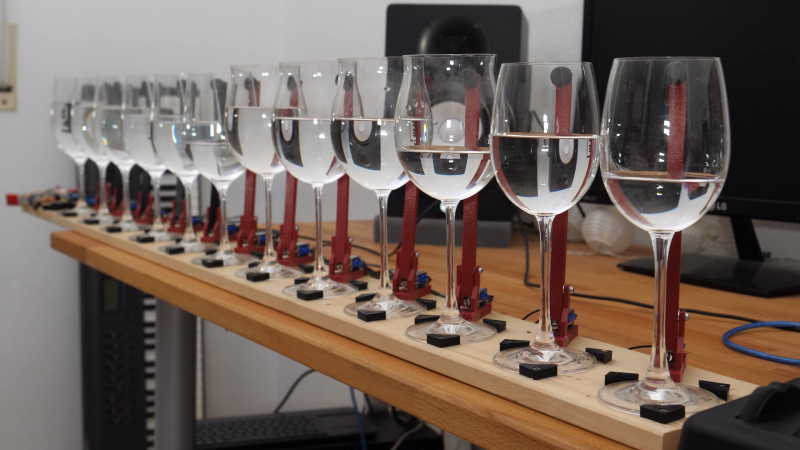It’s common knowledge that tapping a wine glass produces a pitch which can be altered by adjusting the level of the tipple of choice inside. By filling twelve glasses with different amounts of liquid and tuning them to the twelve notes of the scale, it’s possible to make a one-octave instrument – though the speed and polyphony are bottle-necked by the human operator. If you think it sounds like a ripe project for automation, you’re correct: [Bitluni’s lab] has done what needed to be done, and created a MIDI instrument which plays the glasses using mallets.
Electronically it’s a simple build – some 12 V solenoids driven by MOSFETs, with an Arduino in charge. For the mechanical build, a 3D printer proved very useful, as each mallet could be made identical, ensuring a consistent tone across all glasses. Rubber covers printed in flexible filament were fitted to reduce the overtones and produce a clearer sound. [Bitluni] also utilised different types of glasses for the low and high pitches, which also helped to improve the clarity of the tone.
MIDI is of course the perfect protocol for this application; simple, lightweight and incredibly widely used, it’s the hacker’s delight for projects like this. The instrument can perform pre-programmed sequences, or be played live with a MIDI controller. Both of these are shown in the video after the break – stick around for a unique rendition of Flight Of The Bumblebee. For a more compact wine glass based music creation solution, we recommend this nifty project, which alters pitch using a water balloon raised and lowered into the glass by a servo.
















It would be wild if he could connect that to a midi keyboard and play it as a keyboard instrument.
30 seconds into the video, he does exactly that.
Oops, I skipped that part
Nice, need to quiet/muffle the solenoids…
Indeed, the solenoids are almost as loud as the sound from the glass. Which is a pity as diverts the attention from the project (glasses making sound). I really like this project but the solenoids need to be silenced otherwise it simply isn’t as nice to listen to. I really like the fact that it is midi controllable. Cool project!
I won’t deny I’ve been very skeptical of arduino and the community surrounding it. But this build is a very good one and the libraries used are good. I’ve done project like these in the past but was always struck by the software/interfacing. For example building just the midi interface from scratch is a lot of work.
A lazy Susan under each glass and a robotic wet finger.
Maybe just one glass and a pump suspended above it.
I like that idea!
whackaday.com
Using your finger on the rim also works and was the basis of the glass harp from the Baroque era.
Also the trick of amplified voice to shatter a (thin) wine glass.
Nice build. Lots of effort and striving to improve. With that in mind I could hear that the hand-held mallet bouncing off the glasses gave a more pleasant tone. The solenoids can be made to make the hammer bounce if the solenoids are restricted from bottoming out with a foam pad, an o-ring, or a felt pad on the core between the coil and the stop washer. It will also quiet the knocking. A flexible hammer shaft also works. Adjust it such that the hammer does not rest on the glass when actuated continuously. Perhaps a hammer force proportional to voltage (pwm) or pulse duration (no pwm) will control volume. Be sure to isolate the solenoids from the wood to keep them quiet. To really finish it off add a soft felt damper that rests on the glass when finished playing the note. I admire your efforts in completing a project instead of what I do … Work out the details and not finish.
I would imagine you could look at how piano hammers work to get some ideas.